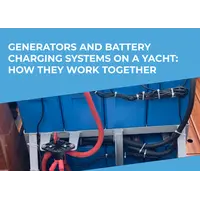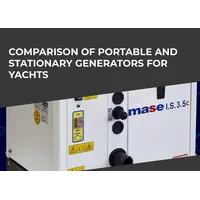When going to sea onboard a monohull or catamaran, it is necessary to have a supply of fresh water, which is used for various purposes: drinking, cooking, taking a shower, washing dishes, using a washing machine that consumes about 30 liters per cycle, etc. At the same time, storing a large amount of water on a vessel can become quite a problem. Since water weighs 8.3 pounds per gallon (1 kilogram per liter), it adds significant weight to your boat when stored, increasing fuel consumption, slowing down, and taking up space.
Carrying fresh water is a daunting task for yachts of any size, and few can afford to store fresh water for several weeks of navigation. Seawater desalination is often the only possible way to obtain drinking water, or simply the most sustainable way to obtain it. For this purpose, a variety of desalination plants of various types, as well as methods of water purification and desalination, are widely used in navigation.
According to the method of desalination, plants are divided into three groups:
Reverse osmosis (the most common and convenient method that is used everywhere).
- Distillation (used on large ships, where water needs are measured in tens of thousands of liters).
- Electrodialysis (when desalination is done with chemical purifiers, it can be very dangerous).
Desalination plants based on the principle of reverse osmosis of water are considered the ideal solution for obtaining high-quality drinking water on various boats.
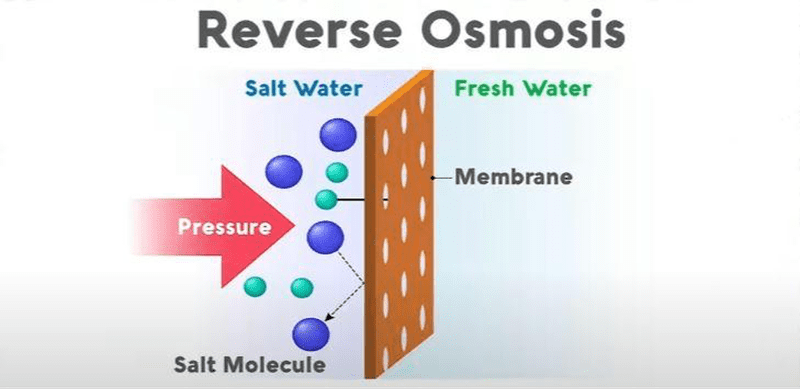
This process involves pumping seawater and then passing it at high pressure through a very thin, semi-permeable membrane with holes a few microns in diameter. The membrane allows pure water molecules to pass through while retaining mineral salts, biological contaminants, bacteria, alkalis and metals. Almost all bottled water that can be found in stores is produced according to the same principle.
It is especially convenient to use this method of purification in cases where it is often necessary to process the water of various types, coming from lakes, rivers or sea. In most cases, fresh lake and river water is highly turbid, therefore, when it is processed using a desalinator, it is recommended to install additional mechanical filters at the system inlet.
Types of Marine Water Makers
The fresh water output of a water maker is specified by the manufacturer and is expressed in liters per hour. The required capacity will depend on the needs of the vessel and the expected consumption in liters per day.
It is also necessary to pay close attention to the intended type of the electrical power. And as with any electrical device, the use of a watermaker results in an increase in overall electricity consumption on board.
There are several types of desalters that use both AC and DC, as well as hybrid versions, as well as manual mechanical watermakers.
[vitrina]1687,1812,1686,6481,1820,1813[/vitrina]
Pros and Cons of Manual Water Makers
Manual distillers are designed to produce drinking water by reverse osmosis without the use of electricity. Such device can be a part of boat’s rescue equipment or used as additional equipment. It is both compact and easy to transport.
Serves as a simple and cost-efficient solution to the problem of obtaining fresh water on board small and medium sized boats. Keep in mind, that it doesn’t have high productivity: it can provide from 1 to 2.5 liters per hour, and you will also need to constantly participate in the cleaning process personally and engage in some physical exercise, makes such distillers an auxiliary tool, and not the main source of purified water.
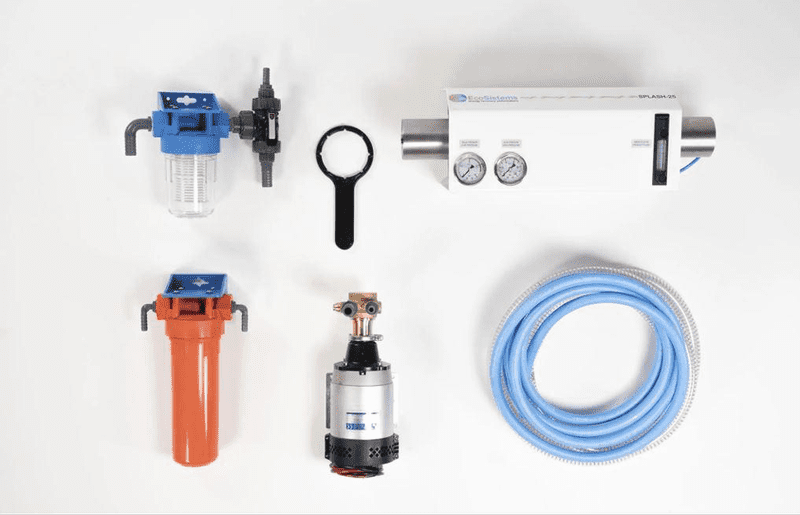
There are also very compact manual water makers for small boats less than 10 meters, with very low power consumption and an output of about 25 liters per hour.
Pros and Cons of DC Powered Water Makers
Powered water makers (DC) for 12 or 24 volts are powered by the ship's on-board network and batteries. These models are well suited for electrical circuits operating in conjunction with alternative energy sources such as solar panels.
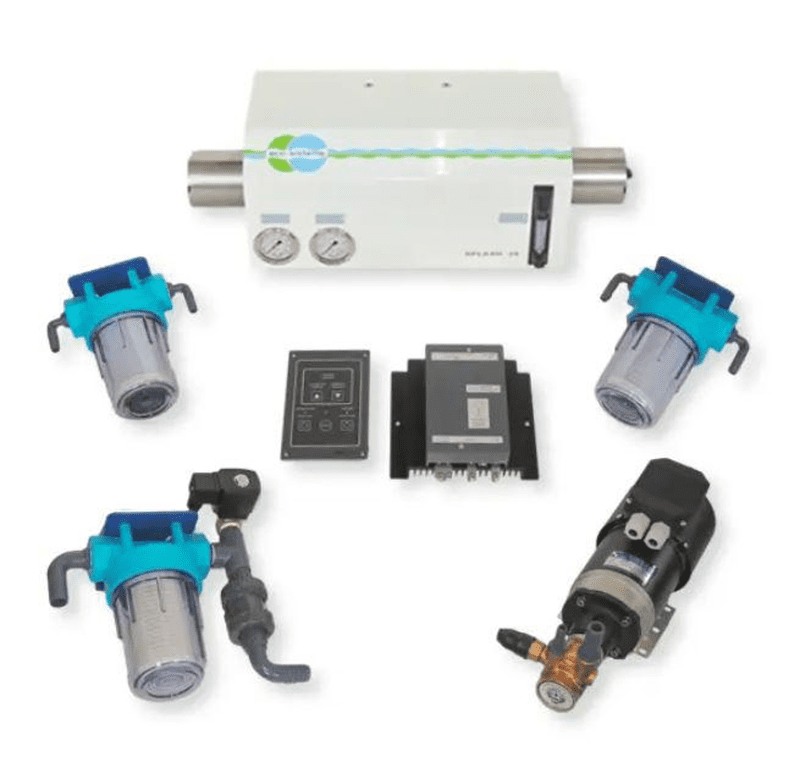
This type of automatic desalination machine guarantees the production of fresh clean water with a minimum of effort at any time convenient for you. It is worth considering that the electric motors of direct current makers may require replacement of filters from time to time, and it is better to order an additional kit in advance from the manufacturer.
If the performance is lower than stated, this may be due to the fact that the section of the electrical cables is not enough, which creates a voltage drop between the batteries and the desalinator.
The cons in this case include the dependence of the device on the battery life and voltage in the network for the output capacity of liters per hour. If the batteries start to run low, the team will have to start the engine to recharge them in order to keep the water generator running.
Pros and Cons of AC-Powered Water Makers
A 110- or 220-volt AC powered desalination system is great for boats with an installed generator and fuel supplies. Such a system is very popular due to its simplicity and reliability. In addition, it is versatile and can be used in tandem with a generator or inverter, even on land. If you charge batteries with a generator occasionally and it has enough fuel, then at the time of its operation, you can also turn on the distiller and fill the tanks with fresh water.
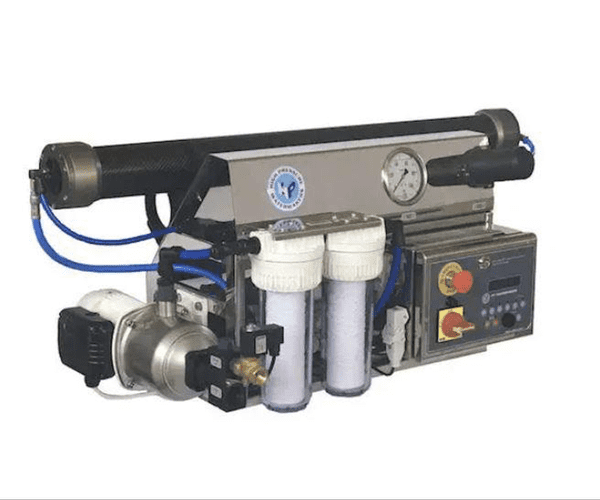
These models are really dependent on the generator though. If an inverter is included in the circuit, and especially if there is only one in the system, you must remember that the inverter power is limited, and when the watermaker is operating, other consumers of electricity, such as navigation or household equipment, will not receive it. For example, a 3000 VA inverter with a long-term rating of 2400 W will need to allocate about 800 W or more, depending on the desalter model, for its operation.
Pros and Cons of Hybrid Water Makers
In addition to desalination devices with conventional power sources, there are units with the ability to be fed both from batteries and from a generator, as well as from curious energy-saving systems like Energy Recovery, where part of the flow from the high-pressure membrane is fed to the lower part of the pump piston, which makes it possible to recover more than 50% of the energy. Of course, such devices are more expensive and more difficult to repair, but they can reduce energy consumption by almost half.
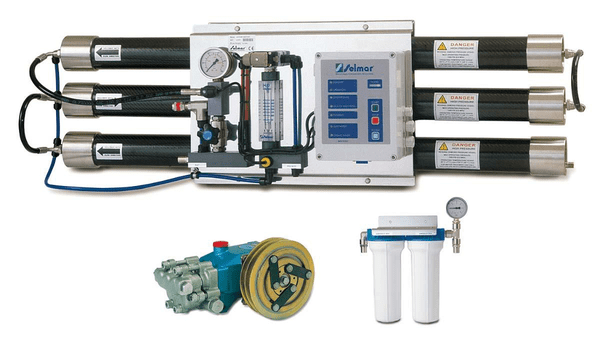
There is also a power drive from the engine through a belt: this system is quite effective, since the distiller works simultaneously with the engine. The produced water is then stored in tanks. However, this system requires a large amount of free space in the engine compartment, which is rarely the case in small boats. Installing a belt drive from the engine may be suitable for larger boats.
Factors to Consider When Choosing a Marine Water Maker
Both your life and your passengers’ fates could one day depend on this complicated device in case of an accident in the middle of the ocean. That’s why it better to make an educated choice when it comes to buying one.
Performance
Try to determine as accurately as possible the required production capacity of the disalinator. The choice of capacity will also depend on the number of hours the desalter will be used daily.
An overestimation of water needs creates the risk of oversizing the installation and, as a result, leads to insufficient use and more weight on board. Leaving the unit with standing water inside for a long time can also cause the filters and membranes to become clogged with dirt and bacteria. Basically, it better keep pumping that water at all times!
However, in the case of large boats, real water needs are most often underestimated. It is important to calculate the amount of water needed to keep the crew comfortable on board, not just the minimum amount of water needed to survive. Underestimating water needs can lead to serious everyday conflicts within the crew. The best way to determine the required amount of production is to calculate the daily consumption of water on board during a shorter sailing period before purchasing a watermaker for long cruises and only then make the purchase.
Installation
Our experience tells us that another important factor is the availability of free space on a yacht or catamaran for the installation of a watermaker. Manufacturers usually offer stand-alone and modular installation options.
The stand-alone version is a one-piece design in a single housing, to install it the owner only needs to connect the power supply and water source - you can start the device right after. Data on the state of the device is displayed on a remote-control panel. Ease of installation will require a spacious engine room and a somewhat intricate maintenance plan in the long run.
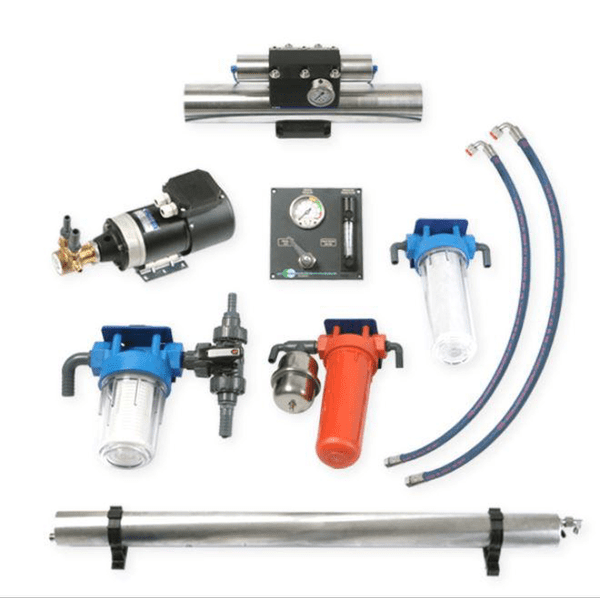
A modular distiller is provided as a kit, the elements of which you arrange at will in locations that are comfortable for you, which is very convenient in the conditions of a constant lack of space on boats, and also facilitates access during maintenance. Mobile installations are not necessarily less bulky than fixed installations, but they can be moved as needed around the boat and completely removed if they are not necessary for a particular voyage, thereby freeing up space.
Additional Factors
Noise and vibration levels increase as power and performance go up. However, since sailors are known to appreciate the calm navigation, manufacturers take this aspect into account when designing watermakers. Some models guarantee a minimum noise level that remains almost imperceptible.
The energy consumption of conventional desalination plants is significantly higher than those equipped with Energy Recovery systems, yet the cost of the latter is much more expensive. In addition, it is worth considering the cost of replacing membranes, installing additional filters, an ultraviolet emitter, equipping the device with cartridges – all of these can affect both cash costs and energy consumption.
Some models of water makers for yachts have a remote control function, which makes it much easier to monitor the process. Such devices are suitable for use on both sailing and motor yachts.



